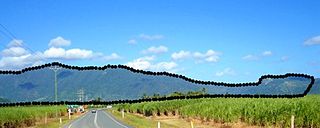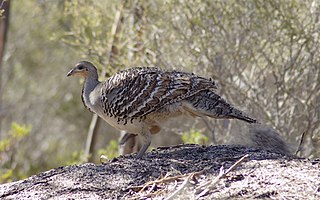
Australian Aboriginal religion and mythology is the sacred spirituality represented in the stories performed by Aboriginal Australians within each of the language groups across Australia in their ceremonies. Aboriginal spirituality includes the Dreamtime, songlines, and Aboriginal oral literature.

The City of Port Augusta is a local government area located at the northern end of Spencer Gulf in South Australia. It is centred on the town of Port Augusta. The city was the site of South Australia's main power supplier, the Port Augusta powerhouse, located on the coast of the Spencer Gulf.

The Mount Remarkable District Council is a local government area located between the top of the Spencer Gulf and the base of the Southern Flinders Ranges in South Australia. The district encompasses a wide variety of towns, including coastal ports and agricultural centres. The economy of the district council is largely based on agriculture.
Koonalda Cave is a cave in the Australian state of South Australia, on the Nullarbor Plain in the locality of Nullarbor. It is notable as an archeological site.

Yumbarra Conservation Park, formerly the Yumbarra National Park, is a protected area in the Australian state of South Australia located about 55 kilometres north of the town centre of Ceduna.
The Corporate Town of Port Augusta West was a local government area in South Australia centred on the suburb of Port Augusta West. It was gazetted on 6 October 1887. They met in council chambers in Loudon Road, which ceased to be used by its successor council upon its amalgamation, but remained in use by the community until their demolition in the 1940s, at which time the building was described as "definitely unsafe". It was not uncommon for positions to be elected unopposed or without any nominations at all; in the election of November 1903, no one nominated for either mayor or councillor.
The Corporate Town of Davenport was a local government area in South Australia that existed from 1887 to 1932 on land now located within the suburb of Port Augusta.
The District Council of Port Germein was a local government area in South Australia, centred on the town of Port Germein. It was gazetted on 5 January 1888 under the provisions of the District Councils Act 1887 and encompassed the hundreds of Baroota, Wongyarra, Booleroo, Telowie, Darling and Appila. It replaced an abortive earlier municipality, the Corporate Town of Port Germein, which had been established on 15 September 1887 when residents, concerned about increased taxation and their interests being lost in a broader shire under the forthcoming reforms, decided to incorporate the town. The local residents reportedly regretted the decision, and when the Act passed late in the year creating the new District Council, state parliament agreed to amalgamate the Corporate Town into the new municipality.
The District Council of Wilmington was a local government area in South Australia, centred on the town of Wilmington from 1888 to 1980.

The District Council of Kanyaka was a local government area in South Australia that existed from 1888 to 1969.

County of Fergusson is a cadastral unit located in the Australian state of South Australia which spans Yorke Peninsula south of Price. It was proclaimed in 1869 by Governor Fergusson after whom the county was named.
The Avenue Range Station massacre was a murder of a group of Aboriginal Australians by white settlers during the Australian frontier wars. It occurred in about September 1848 at Avenue Range, a sheep station in the southeast of the Colony of South Australia.

The County of Newcastle is one of the 49 counties of South Australia spanning the central Flinders Ranges. It was named in 1876 for Francis Pelham-Clinton-Hope, the eighth Duke of Newcastle.

Saltia is a locality in the Australian state of South Australia located on the western side of the Flinders Ranges about 279 kilometres (173 mi) north of the state capital of Adelaide and about 19 kilometres (12 mi) east of the city of Port Augusta.
The Hundred of Davenport is a cadastral hundred within the County of Frome in South Australia, proclaimed in 1860.

The County of Frome is one of the 49 cadastral counties of South Australia in straddling the Mid North and Flinders Ranges regions. It was proclaimed in 1851 by Governor Henry Young and was named for the former Surveyor-General of South Australia, Edward Charles Frome. The iconic Mount Remarkable in the Hundred of Gregory is at the centre of the county.

County of Taunton is a cadastral unit located in the Australian state of South Australia on land on the east coast of Lake Torrens about 160 kilometres (99 mi) from the city of Port Augusta. It was proclaimed in 1877 and named after Lord Taunton who was the Secretary for the Colonies from 1855 to 1858. It has been partially divided in the following sub-units of hundreds – Bunyeroo, Carr, Edeowie, Nilpena, Oratunga and Parachilna.
Woolundunga is a locality in the Australian state of South Australia located on the western side of the Flinders Ranges about 271 kilometres (168 mi) north of the state capital of Adelaide and about 21 kilometres (13 mi) south-east of the city of Port Augusta.
Woolundunga may refer to.











